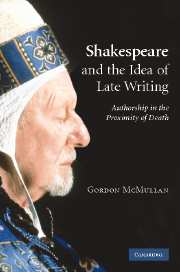Book contents
- Frontmatter
- Contents
- Acknowledgements
- Introduction
- 1 Shakespeare and the idea of late writing: authorship in the proximity of death
- 2 The Shakespearean caesura: genre, chronology, style
- 3 The invention of late Shakespeare: subjectivism and its discontents
- 4 Last words/late plays: the possibility and impossibility of late Shakespeare in early modern culture and theatre
- 5 How old is ‘late’? Late Shakespeare, old age, King Lear
- 6 The Tempest and the uses of late Shakespeare in the theatre: Gielgud, Rylance, Prospero
- Notes
- Index
6 - The Tempest and the uses of late Shakespeare in the theatre: Gielgud, Rylance, Prospero
Published online by Cambridge University Press: 22 September 2009
- Frontmatter
- Contents
- Acknowledgements
- Introduction
- 1 Shakespeare and the idea of late writing: authorship in the proximity of death
- 2 The Shakespearean caesura: genre, chronology, style
- 3 The invention of late Shakespeare: subjectivism and its discontents
- 4 Last words/late plays: the possibility and impossibility of late Shakespeare in early modern culture and theatre
- 5 How old is ‘late’? Late Shakespeare, old age, King Lear
- 6 The Tempest and the uses of late Shakespeare in the theatre: Gielgud, Rylance, Prospero
- Notes
- Index
Summary
I'm going to revive Prospero next year in The Tempest which is another role I love playing and you can do that pretty well until you're ninety so I can have another bash at that one.
The play was, of course, Shakespeare's swansong.
If The Tempest did not exist, it would be necessary to invent it.
I have argued that, almost as soon as the discourse of lateness was established as a concept within the general culture of creativity, it became subject to certain complicities; that ‘genuine’ lateness became impossible to distinguish from ‘knowing’ lateness, from lateness striven for and assumed by a given artist. Henry James's ‘Middle Years’, as I have shown, makes this clear, and the late James's engagement – indeed, obsession – with the Shakespearean late phase and in particular with The Tempest as the supreme embodiment of late Shakespeare demonstrates Shakespeare's centrality to the idea of late style as it developed in twentieth-century literary culture as the poetic counterpart to late Beethoven in musicology and late Rembrandt in art history. I have noted, too, that Edward Said's turn to the analysis of late style coincided with his own later years and terminal illness. Late Shakespeare has also, unsurprisingly, been an object of particular interest for critics late in life, who demonstrate a susceptibility to the extension of subjectivism offered by the idea of late writing, from the association of the late author with the late work to that of the late critic with the late author.
- Type
- Chapter
- Information
- Shakespeare and the Idea of Late WritingAuthorship in the Proximity of Death, pp. 318 - 353Publisher: Cambridge University PressPrint publication year: 2007



